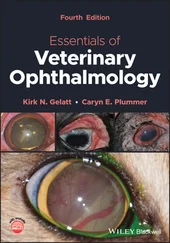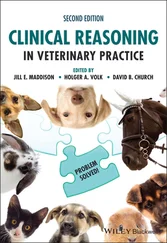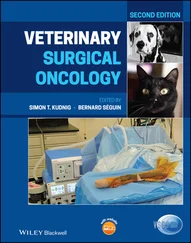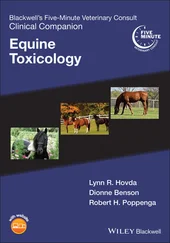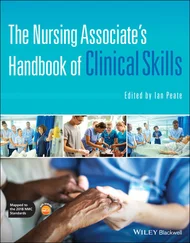Veterinary Clinical Skills
Здесь есть возможность читать онлайн «Veterinary Clinical Skills» — ознакомительный отрывок электронной книги совершенно бесплатно, а после прочтения отрывка купить полную версию. В некоторых случаях можно слушать аудио, скачать через торрент в формате fb2 и присутствует краткое содержание. Жанр: unrecognised, на английском языке. Описание произведения, (предисловие) а так же отзывы посетителей доступны на портале библиотеки ЛибКат.
- Название:Veterinary Clinical Skills
- Автор:
- Жанр:
- Год:неизвестен
- ISBN:нет данных
- Рейтинг книги:5 / 5. Голосов: 1
-
Избранное:Добавить в избранное
- Отзывы:
-
Ваша оценка:
- 100
- 1
- 2
- 3
- 4
- 5
Veterinary Clinical Skills: краткое содержание, описание и аннотация
Предлагаем к чтению аннотацию, описание, краткое содержание или предисловие (зависит от того, что написал сам автор книги «Veterinary Clinical Skills»). Если вы не нашли необходимую информацию о книге — напишите в комментариях, мы постараемся отыскать её.
Provides instructors and students with clear guidance on best practices for clinical skills education Veterinary Clinical Skills
Veterinary Clinical Skills
Veterinary Clinical Skills — читать онлайн ознакомительный отрывок
Ниже представлен текст книги, разбитый по страницам. Система сохранения места последней прочитанной страницы, позволяет с удобством читать онлайн бесплатно книгу «Veterinary Clinical Skills», без необходимости каждый раз заново искать на чём Вы остановились. Поставьте закладку, и сможете в любой момент перейти на страницу, на которой закончили чтение.
Интервал:
Закладка:
14 Hughes, K., Rhind, S., Mossop, L., et al. 2018. ‘Care about my animal, know your stuff and take me seriously’: United Kingdom and Australian clients’ views on the capabilities most important in their veterinarians. Vet Rec, 183, 534.
15 Kreisler, R., Stackhouse, N., Graves, T. 2019. Arizona veterinarians’ perceptions of and consensus regarding skills, knowledge and attributes of day one veterinary graduates. J Vet Med Educ, 47, 365–377.
16 Luby, C., McIntyre, K., Jelinski, M. 2013. Skills required of dairy veterinarians in Western Canada: A survey of practicing veterinarians. Can Vet J, 54, 267–270.
17 Matthew, S. M., Bok, H. G, Chaney, K. P., et al. 2020. Collaborative development of a shared framework for competency‐based veterinary education. J Vet Med Educ, 47, 578–593.
18 May, S. A., Head, S. D. 2010. Assessment of technical skills: Best practices. J Vet Med Educ, 37, 258–265.
19 May, S. A. 2015. Towards a scholarship of primary health care. Vet Rec, 176, 677.
20 Michels, M., Evans, D., Blok, G. 2012. What is a clinical skill? Searching for order in chaos through a modified Delphi process. Med Teach, 34, e573–e581.
21 Miller, G. E. 1990. The assessment of clinical skills/competence/performance. Acad Med, 65, S63–S67.
22 Molgaard, L., Hodgson, J., Bok, H., et al. 2018a. Competency‐Based Veterinary Education: Part 1 ‐ CBVE Framework. Washington, DC: Association of American Veterinary Medical Colleges.
23 Molgaard, L., Hodgson, J., Bok, H., et al. 2018b. Competency‐Based Veterinary Education: Part 2 ‐ Entrustable Professional Activities. Washington, DC: Association of American Veterinary Medical Colleges.
24 Molgaard, L. K., Chaney, K. P., Bok, H. G, et al. 2019. Development of core entrustable professional activities linked to a competency‐based veterinary education framework. Med Teach, 41, 1404–1410.
25 NAVMEC. 2011. Roadmap for Veterinary Medical Education in the 21st century. Washington, DC: North American Veterinary Medical Education Consortium.
26 Norcini, J., Anderson, M., Bollela, V., et al. 2018. 2018 Consensus framework for good assessment. Med Teach, 40, 1102–1109.
27 Perrin, H. C. 2019. What are employers looking for in new veterinary graduates? A content analysis of UK veterinary job advertisements. J Vet Med Educ, 46, 21–27.
28 Petersa, H., Holzhausena, Y., Boscardinb, C., et al. 2017. Twelve tips for the implementation of EPAs for assessment and entrustment decisions. Med Teach, 39, 802–807.
29 Pirkelbauer, B., Pead, M., Probyn, P., et al. 2008. LIVE: The creation of an academy for veterinary education. J Vet Med Educ, 35, 567–572.
30 Pusic, M., Boutis, K., Hatala, R., et al. 2015. Learning curves in health professions education. Acad Med, 90, 1034–1042.
31 Read, E., Hecker, K. 2013. The development and delivery of a systematic veterinary clinical skills education program at the University of Calgary. J Veterinar Sci Technolo, S4, 004.
32 Rhind, S., Baillie, S., Brown, F., et al. 2008. Assessing competence in veterinary medical education: Where’s the evidence? J Vet Med Educ, 35, 407–411.
33 Rhind, S., Baillie, S., Kinnison, T., et al. 2011. The transition into veterinary practice: opinions of recent graduates and final year students. BMC Med Educ, 11, 64.
34 Royal College of Veterinary Surgeons (RCVS). 2020. Day One Competences Statement. https://www.rcvs.org.uk/document‐library/day‐one‐competences‐statement/Accessed May 28, 2021.
35 Salisbury, S. K., Chaney, K. P., Ilkiw, J. E., et al. 2019. Competency‐Based Veterinary Education: Part 3 ‐ Milestones. Washington, DC: Association of American Veterinary Medical Colleges.
36 Scalese, R. J., Issenberg, S. B. 2005. Effective use of simulations for the teaching and acquisition of veterinary professional and clinical skills. J Vet Med Educ, 32, 461–467.
37 Smeak, D. 2007. Teaching surgery to the veterinary novice: the Ohio State University experience. J Vet Med Educ, 34, 620–627.
38 Smeak, D., Hill, L., Lord, L., et al. 2012. Expected frequency of use and proficiency of core surgical skills in entry‐level veterinary practice: 2009 ACVS core surgical skills diplomate survey results. Vet Surg, 41, 853–861.
39 ten Cate, O. 2005. Entrustability of professional activities and competency‐based training. Med Educ, 39, 1243–1249.
40 ten Cate, O., Graafmans, L., Posthumus, I., et al. 2018. The EPA‐based Utrecht undergraduate clinical curriculum: Development and implementation. Med Teach, 40, 506–513.
41 ten Cate, O., Carraccio, C., Damodaran, A., et al. 2020. Entrustment decision making: Extending Miller’s pyramid. Acad Med, online ahead of print. doi: https://doi.org/10.1097/ACM.0000000000003800.
42 van Melle, E., Frank, J., Holmboe, E., et al. 2019. A core components framework for evaluating implementation of competency‐based medical education. Acad Med, 94, 1002–1009.
43 Welsh, P., Jones, L., May, S., et al. 2009. Approaches to defining day‐one competency: a framework for learning veterinary skills. Rev Sci Tech, 28, 771–777.
2 Clinical Skills Curricula: How Are They Determined, Designed, and Implemented?
Jennifer Hodgson1, Elrien Scheepers2, and Sarah Baillie3
1 Virginia‐Maryland College of Veterinary Medicine, Virginia Tech, Blacksburg, VA, USA
2 Faculty of Veterinary Science, University of Pretoria, Pretoria, RSA
3 Bristol Veterinary School, University of Bristol, Bristol, UK
Box 2.1 Key Messages
The same principles of general curricular design should be adhered to when designing or evaluating a clinical skills curriculum
A six‐step model developed by David Kern provides fundamental, yet flexible, principles of curricular design
Student, societal, professional, and accreditation needs should be considered
A backward design process, with initial attention to the desired outcomes, will focus curricular design
A prioritized Day‐One Competencies list and identified core Entrustable Professional Activities will further drive the design process
Learning objectives for clinical skills must be as specific and measurable as possible
A variety of educational methods may be used to teach clinical skills, which are not restricted to clinical skills laboratories or clinical settings
Implementation of a clinical curriculum will depend on available resources, buy‐in from stakeholders, and a properly planned management and roll‐out plan
Evaluation of the implemented clinical curriculum must be done early and repeated as needed
Introduction
The goal of veterinary curricula is to educate students to be optimally prepared to enter the veterinary profession with entry‐level medical knowledge and appropriate mastery of an array of clinical skills (Read and Hecker, 2013; Dilly et al., 2017; Thomson et al., 2019; Duijn et al., 2020). Not only will the qualified veterinary professional be expected to display knowledge and mastery of skills, but he or she will also have to function as part of the veterinary team, working with veterinary nursing professionals where both the veterinarian and veterinary nurse (or “vet tech”) have input into patient care and treatment (Kinnison et al., 2011). Good veterinary interprofessional practice may have benefits for the practice, the individual team members, the client, and the patient (Kinnison et al., 2014). It can, and should, be argued that this relationship between members of the professional team should be nurtured and developed from an early stage, ideally at the level of educating students. While published studies in interprofessional education interventions are sparse, it must be acknowledged that at teaching institutions where the two groups of students are educated together, opportunities for integrated curriculum design are ample and should be fostered. Even if these opportunities do not exist because of physical separation of teaching facilities, it must be kept in mind that there are many more similarities in designing clinical skills curriculum for veterinary and veterinary nursing/veterinary technology students, than there are differences. This chapter will discuss processes in the design of clinical curricula that are similar for veterinary and veterinary nursing (or veterinary technology, as called in Australia and United States) students.
Читать дальшеИнтервал:
Закладка:
Похожие книги на «Veterinary Clinical Skills»
Представляем Вашему вниманию похожие книги на «Veterinary Clinical Skills» списком для выбора. Мы отобрали схожую по названию и смыслу литературу в надежде предоставить читателям больше вариантов отыскать новые, интересные, ещё непрочитанные произведения.
Обсуждение, отзывы о книге «Veterinary Clinical Skills» и просто собственные мнения читателей. Оставьте ваши комментарии, напишите, что Вы думаете о произведении, его смысле или главных героях. Укажите что конкретно понравилось, а что нет, и почему Вы так считаете.


